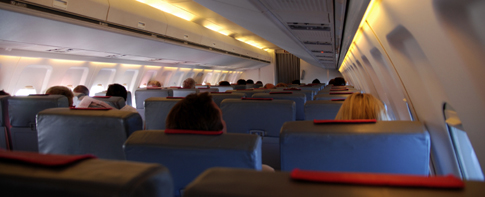Among non-fatal airline and aviation related accidents, turbulence is the leading cause of injuries.
- Each year, approximately 58 people in the United States are injured by turbulence while not wearing their seat belts.
- From 1980 through June 2004, U.S. air carriers had 198 turbulence accidents*, resulting in 266 serious injuries and three fatalities.
- At least two of the three fatalities involved passengers who were not wearing their seat belts while the seat belt sign was illuminated.
- Generally, two-thirds of turbulence-related accidents occur at or above 30,000 feet.

Turbulence can also be amongst the most frightening experiences that even the most seasoned airline travelers face. Severe turbulence can strike without warning, propelling passengers and objects through the cabin, cause serious injuries and seriously damage the aircraft. Turbulence is air movement that normally cannot be seen and may occur unexpectedly. It can be created by many different conditions, including atmospheric pressure, jet streams, air around mountains, cold or warm weather fronts or thunderstorms. Turbulence can even occur when the sky appears to be clear, a phenomenon known as clear air turbulence.
Experienced aviation and flight injury lawyers know that while some degree of turbulence or chop is normal and happens often, when it is more severe it can be dangerous. Turbulence can cause passengers who are not wearing their seat belts to be violently thrown from their seats without warning, to have overhead bins open and cause items to fall, or to cause hot beverages to fall onto passengers causing them serious burns. When turbulence strikes and injuries occur, injured passengers may have a claim against the airlines.
Our airline injury lawyers have over 20 years of experience litigating turbulence claims. We understand that litigating and winning a turbulence claim for our clients requires a certain degree of skill and knowledge of the factors that caused the encounter, prevented the pilots from expecting and warning their passengers, and avoiding the mass of turbulent air.
As aviation attorneys, we work with piloting and weather experts to chart and plot out the aircraft’s route, obtain satellite images of the weather at the time and location of the encounter, and seek to quickly preserve whatever airline data is available to assist in proving our claim.
We utilize all available resources to explore all possible explanations for the cause. Did the pilots review and adhere to their pre-flight weather dispatch, properly operate the aircraft’s weather radar, communicate with air traffic control, follow and listen to the transmissions and warnings of other aircraft in the area? Did the pilots know that there was rough air ahead but decide not to deviate to save time, fuel, and the airlines’ money?
In every turbulence case, we seek the answers to these questions and utilize all of our firm’s experience and resources to obtain justice for our clients. We review all government data and reports, FAA and NTSB findings, and the airlines’ own investigation practices and procedures to obtain full and fair compensation for our clients.
We also understand that even if the pilots were unaware of the impending turbulence, recovery may be available to our clients pursuant to the Montreal Convention governing international air travel.
Aviation attorney Abe Bohrer is among the only airplane accident lawyers in the United States to have tried a turbulence case to verdict in Magan v. Lufthansa, where he won a substantial verdict pursuant to the Montreal Convention on behalf of his client who was injured during significant turbulence. If you or a loved one has been injured during the course of in-flight turbulence, whether during the course of a domestic or international flight, please call or email a flight injuries lawyer from our team today for a free consultation.
*The National Transportation Safety Board defines an accident as an occurrence associated with the operations of an airplane in which any person suffers death or serious injury or in which the aircraft receives substantial damage.

